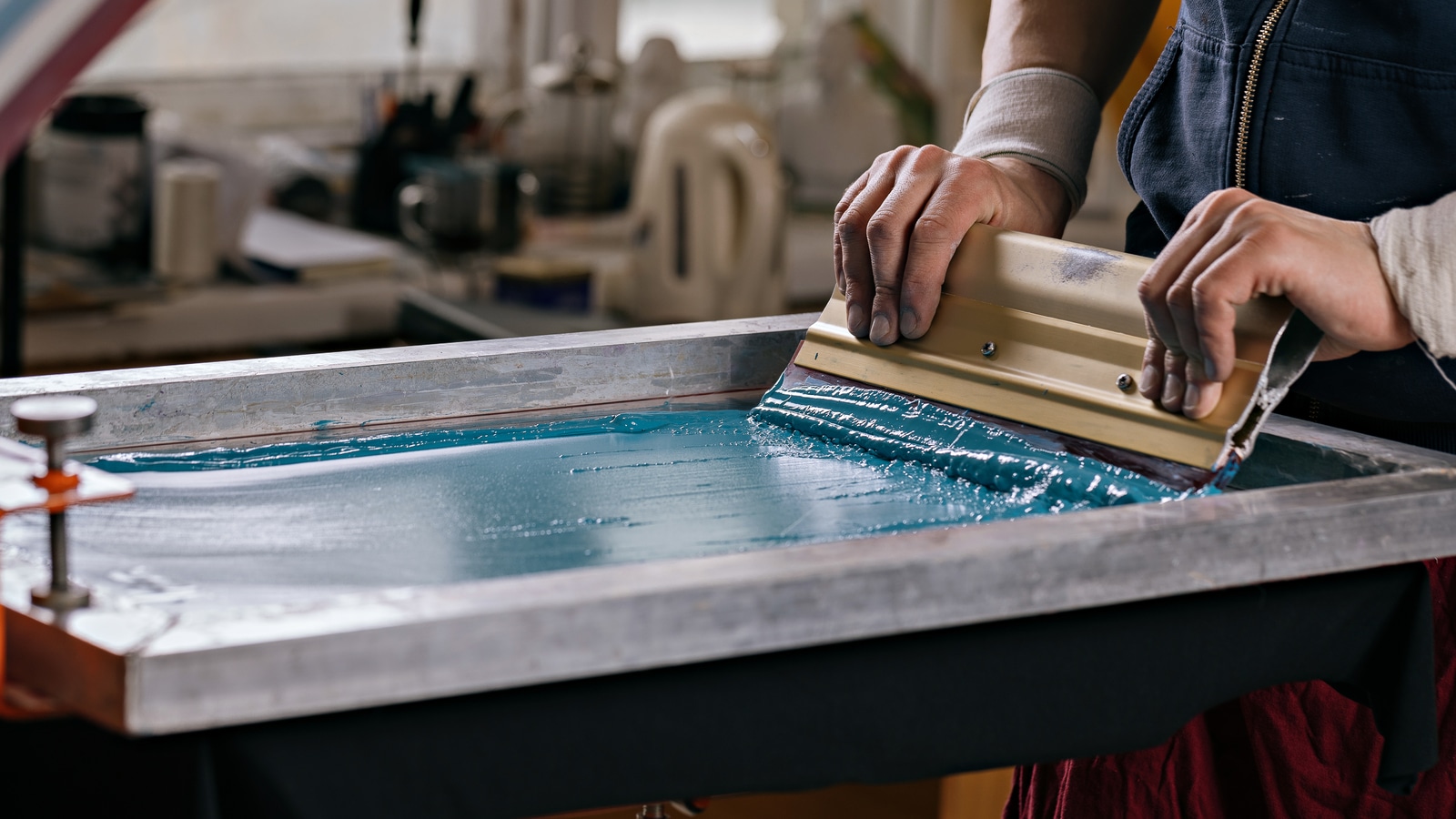Vintage Style Silk Screen Printing for Retro Fashion
Vintage Style Silk Screen Printing for Retro Fashion
Blog Article
Screen Printing Uncovered: Whatever You Need to Find Out About Tee and Garment Printing Methods
If you have actually ever before asked yourself exactly how those vibrant styles finish up on your preferred t-shirts, you remain in the best area. Display printing is an interesting method that integrates art with technique, offering unlimited opportunities for creative thinking. Recognizing the basics, from equipment to ink choices, can substantially influence your outcomes. Prepared to check out the important aspects that make display printing an art type? Allow's discover the information that can raise your projects.
The Basics of Display Printing: Exactly How It Functions
When you plunge right into display printing, you'll discover it's both a science and an art. At its core, display printing entails creating a stencil, or display, that allows ink to pass with only in particular areas.
Next, you'll mix your inks and prepare your printing surface. Setting the display over the material, after that utilize a squeegee to press ink with the screen onto the garment. This process needs accuracy, as you want clear, vibrant prints. After printing, you'll treat the ink with warmth, guaranteeing it abides by the textile and lasts via cleans. Each step is crucial, and understanding them will certainly elevate your display printing abilities, changing simple garments into special, meaningful pieces.
Kinds Of Screen Printing Strategies
Once you understand the basics of screen printing, it's time to check out the different methods that can raise your designs. One popular technique is standard screen printing, where ink is pressed via a stenciled display.
Another option is plastisol printing, understood for its durability and dazzling colors, making it a favorite for lots of brand names. Experiment with halftone printing to produce gradient impacts and intricate layouts.
Important Tools for Screen Printing
To achieve magnificent lead to screen printing, having the best devices is essential. First, you'll require a sturdy display printing structure, which holds the mesh that transfers your layout onto the garment. Next off, purchase high-quality squeegees; these are essential for using ink evenly throughout the display. You'll also need a good direct exposure device to create your screens, along with a washout booth for cleaning them after usage. A dependable heat resource, like a conveyor clothes dryer or warm press, is critical for treating your prints to assure longevity. Don't fail to remember a correct office, equipped with tables and storage for your supplies. Lastly, safety gear, such as masks and gloves, will keep you secure from chemicals and inks. With the right devices, you'll be well on your means to producing professional-quality prints.
Choosing the Right Inks and Products
When choosing inks and products for display printing, you need to take into consideration the kind of ink that works best for your job. Think concerning textile compatibility to assure your styles look terrific and last lengthy. Explore environment-friendly ink choices to make your printing process more lasting.
Sorts Of Screen Inks
Choosing the right display ink is necessary for attaining vivid, durable prints that fulfill your job's requirements. There are numerous types of display inks to take a look at. Specialty inks, such as metallic or glow-in-the-dark, can add one-of-a-kind results to your designs.

Fabric Compatibility Considerations
Understanding material compatibility is essential for achieving premium display prints, especially because various materials react distinctively to numerous inks. Constantly evaluate your inks on example textile to assure they stick properly and maintain shade honesty. Additionally, keep in mind that textile weight and appearance can affect the final result, so picking the appropriate ink and material combination is vital for your task's success.
Eco-Friendly Ink Options
Environmentally friendly inks are ending up being a prominent selection for display printers who intend to lessen their environmental effect while preserving high quality. When choosing inks, think about water-based inks, which are much less hazardous and easier to clean up compared to standard solvents. These inks bond well with materials, delivering lively results without harmful chemicals. You may likewise explore eco-solvent inks that use less volatile natural substances (VOCs), making them a safer alternative for both your wellness and the world.
In addition, look for inks made from renewable energies, such as soy or vegetable-based options. By selecting the best inks and products, you'll not just produce magnificent styles however likewise add to a more sustainable printing process. Make the switch, and your prints will show your commitment to the environment!
Preparing Your Style for Screen Printing

File Format Requirements
To ensure your style looks dynamic and sharp on textile, you'll require to pay close focus to file style needs for screen printing. Make sure your layout has a clear history to protect against unwanted white edges on your prints. Keep color settings in mind; CMYK is common for display printing, so transform your RGB creates as necessary.
Color Separation Techniques
Color splitting up is an essential action in preparing your style for display printing, and mastering it can considerably boost your print high quality. You'll require to damage your design right into private shades, as each shade calls for a separate display throughout printing. Begin by determining all the shades in your layout and produce layers each. You can utilize software like Adobe Photoshop or Illustrator to isolate and different shades successfully. Be particular to save each layer as a different data, usually in a format like TIFF or PSD. This precision not just ensures precise shade depiction however additionally enhances the printing procedure. By taking notice of shade splitting up, you'll attain expert and vibrant lead to your screen-printed garments.
Resolution and Size
Achieving the most effective outcomes in screen printing starts with guaranteeing your layout has the ideal resolution and size. Preferably, your art work must be at least 300 DPI (dots per inch) for sharp, clear prints. If you use lower resolution, your last product might look amateur and pixelated.
When it comes to dimension, take into consideration the measurements of your print area. Design your artwork to match the final print dimension, ideally producing it in the actual dimensions you'll be printing. This means, you'll avoid any kind of unexpected scaling concerns.
Constantly inspect your design in both vector and raster formats. Vector graphics can be scaled without shedding high quality, making them optimal for screen printing. Preparing correctly will ensure your design looks amazing on every garment!
Step-by-Step Display Printing Refine
Screen printing is a dynamic process that enables you to create dynamic designs on numerous surface areas. To obtain started, you'll need a screen, emulsion, and your picked ink.
After washing out the unexposed emulsion, your screen is prepared. Establish it up on your printing surface area and straighten your garment underneath it. Put ink onto the display and make use of a squeegee to push the ink through the stencil onto the fabric. Raise the screen very carefully and allow the print completely dry. Finally, cure the ink utilizing heat to assure longevity. That's it! You've efficiently screen published your layout.
Tips for Successful Screen Printing Projects
While you're diving into your screen printing tasks, keep in mind that prep work is key to success. Beginning by collecting all your materials-- inks, garments, screens, and squeegees. A clean work space assists prevent unwanted errors, so tidy up prior to you start.
Next, verify your artwork is high-resolution and correctly sized for your garment. Check your screen for appropriate direct exposure and clean it extensively to avoid smudges. When mixing your inks, follow the manufacturer's standards to attain the right uniformity.
Throughout printing, use also pressure with your squeegee for regular results. Do not rush; take your time to verify each print fulfills your standards. After printing, let your garments dry totally prior to managing or packaging them.
Last but not least, constantly maintain a sample of your help future reference. By doing this, you can assess your progression and boost your strategies over time. Satisfied printing!

Frequently Asked Questions
Exactly how Long Does It Take to Establish a Screen Printing Work?
Establishing a display printing task typically takes around half an hour to an hour. You'll prepare the displays, mix inks, and readjust This Site the press. The moment differs based on intricacy and experience, so remain organized!
Can I Publish on Various Textile Types Using the Same Method?
Yes, you can publish on various material types making use of the same method, however you'll need to readjust your setups and inks. Some fabrics soak up ink differently, so exploring warranties the finest results for each product.
What Are Usual Blunders to Prevent in Screen Printing?
When screen printing, prevent usual errors like utilizing the wrong ink, neglecting proper basics direct exposure times, or skipping pre-press checks. Always check your configuration and preserve tidy displays to ensure quality results each time.
Exactly How Can I Properly Clean and Preserve My Screen Printing Equipment?
To effectively tidy and keep your display printing tools, you must frequently wash screens with suitable solvents, inspect mops for wear, and guarantee all devices are stored dust-free and dry. Consistency boosts and stops costly repairs efficiency.
Is Screen Printing Eco-friendly Contrasted to Various Other Approaches?
Display printing can be extra ecologically friendly than various other methods, particularly if you utilize eco-conscious products and water-based inks. By choosing sustainable supplies and practices, you minimize waste and reduce your effect on the earth.
Screen Printing Uncovered: Everything You Need to Know Regarding Tee and Garment Printing Methods
At its core, display printing includes producing a stencil, or screen, that allows ink to pass with only in specific areas. Position the display over the material, after that make use of a squeegee to push ink with the screen onto the garment. One prominent method is traditional display printing, where ink is pressed through a stenciled screen.When picking inks and materials for screen printing, you require to take into account the type of ink that functions ideal for your task.
Report this page